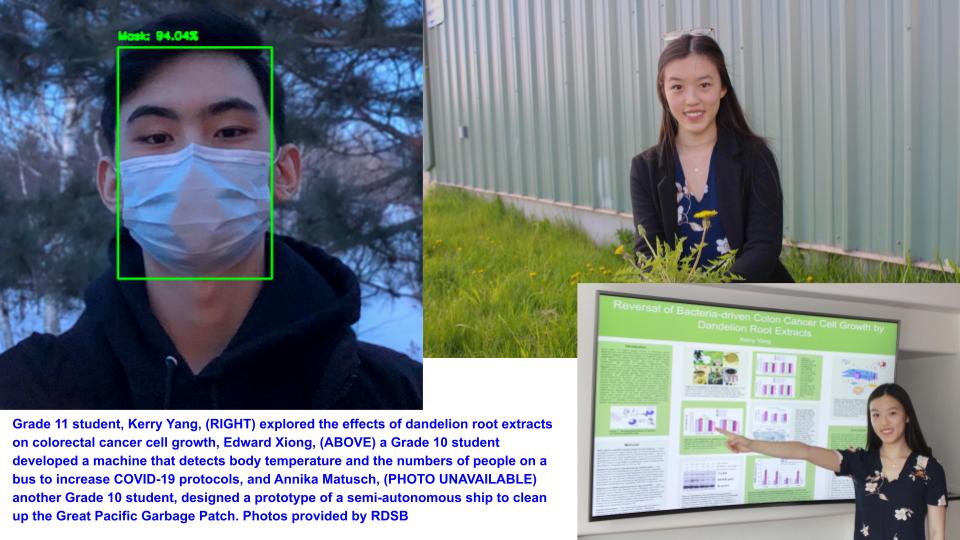Three students from Rainbow Schools are showcasing their scientific discoveries at the Canada-Wide Science Fair.
Board education director Norm Blaseg says the three LoEllen school students won the right to attend nationals for their projects at the Sudbury Regional Science Fair.
Blaseg says Grade 11 student, Kerry Yang, explored the effects of dandelion root extracts on colorectal cancer cell growth, Edward Xiong, a Grade 10 student developed a machine that detects body temperature and the numbers of people on a bus to increase COVID-19 protocols, and Annika Matusch, another Grade 10 student, designed a prototype of a semi-autonomous ship to clean up the Great Pacific Garbage Patch.
The virtual Canadian competition is now underway with winners announced this Saturday.
More details of the student’s projects are below.
Kerry Yang, explored the effects of dandelion root extracts on colorectal cancer cell growth. Colorectal cancer is a leading cause of cancer-related deaths and affects an estimated four per cent of the world’s population. Some components of dandelion root extracts have been known to combat antibiotic resistance, inflammation, and digestive diseases, however, their roles against bacteria-driven colon cancer cell growth have yet to be researched.
Kerry found that dandelion root extracts and taraxasterol (the main component of dandelion root extracts) were independently successful in reversing lipopolysaccharides-induced colon cancer cell growth by targeting the genetic coding, effectively stopping the production of pro-inflammatory genes and preventing cancer cell growth.
Kerry’s project suggests the promising potential of dandelion root extracts and taraxasterol against lipopolysaccharide-induced colorectal cancer.
For her project “Reversal of Bacteria-driven Colorectal Cancer Cell Growth by Dandelion Root Extracts”, Kerry received First Place, Senior Division, Life Sciences, the Biology Award, the Chemistry/Biochemistry Award, the Jack and Maija Ceming Chemistry Award, and Best in Fair.
Edward Xiong, created “Autonomous Prevention of Bus Overcrowding and Mask Detection.” Edward’s research showed that six per cent of people commuting on the Toronto Transition Commission (TTC) were not wearing masks properly, increasing the likelihood of community transmission of COVID-19.
In an effort to limit the spread, Edward developed a device that uses machine learning to count the number of people getting on and off the bus. The device sends a message to TTC management if the bus is overcrowded.
The device also uses machine learning to determine if passengers are wearing their mask properly, and uses an infrared camera to determine each person’s temperature as they board the bus. If a person is not wearing a mask and has a fever, an alert is sent to TTC management. These alerts will allow TTC to add more buses on overcrowded routes, and inform Public Health of any potential risk for close contact with a possible COVID-19 case on a bus route.
For his efforts, Edward Xiong garnered First Place, Intermediate Division, Engineering, the OPG Engineering Award, the Founding Members’ Award, and the Science, Engineering and Architecture Award – Engineering.
Annika Matusch designed a semi-autonomous ship to clean up the Great Pacific Garbage Patch, the largest collection of waste on the planet with over 80,000 tons of plastic. The ship uses two booms with a 30-metre spread to collect trash and direct items into grated conveyors. The trash is drained and brought into a main compartment, then to an industrial-grade shredder, which uses pyrolysis to turn the materials into syngas and char.
Syngas will provide electrical generation, and the ship will be able to convert approximately 720 kilograms of waste per day into 12.7 gigajoules, enough energy to run every component of the system. With a projected cost of $7.5 million, the system turns waste into sustainable energy on the spot, making the solution realistic, cost-effective and energy-neutral.
Annika’s project “Cleaning Up the Great Pacific Garbage Patch: Designing a Sustainable Solution Using Pyrolysis” garnered First Place, Intermediate Division, Engineering, the FROSKR Environmental Award, as well as the OPG Energy, Environmental and Engineering Awards.
“We are so proud of our young scientists for their exceptional achievement,” adds Blaseg. “Our community will be well represented at the national level. We wish all participants continued success as they showcase their impressive research among their peers from across Canada.”
Rainbow District School Board congratulates all Sudbury Regional Science Fair winners.


